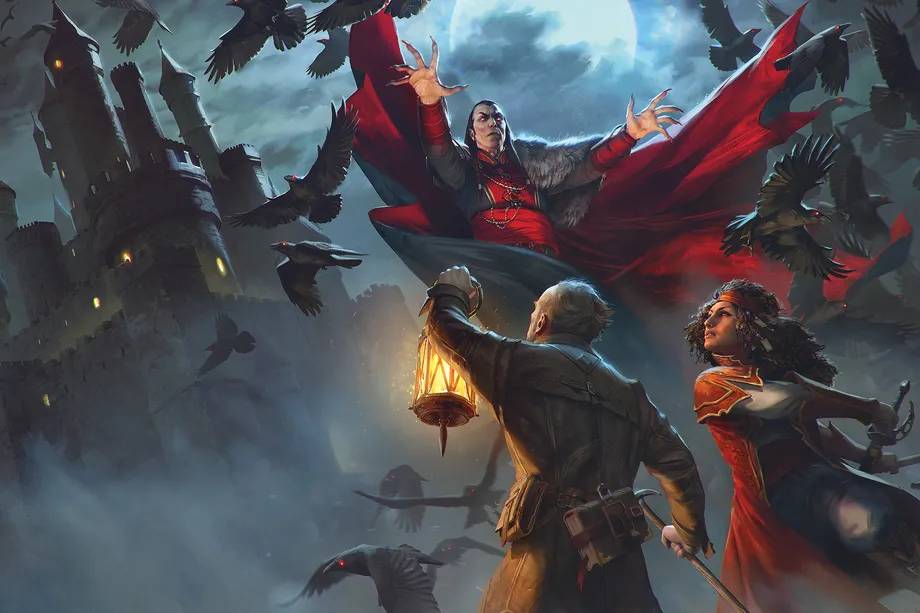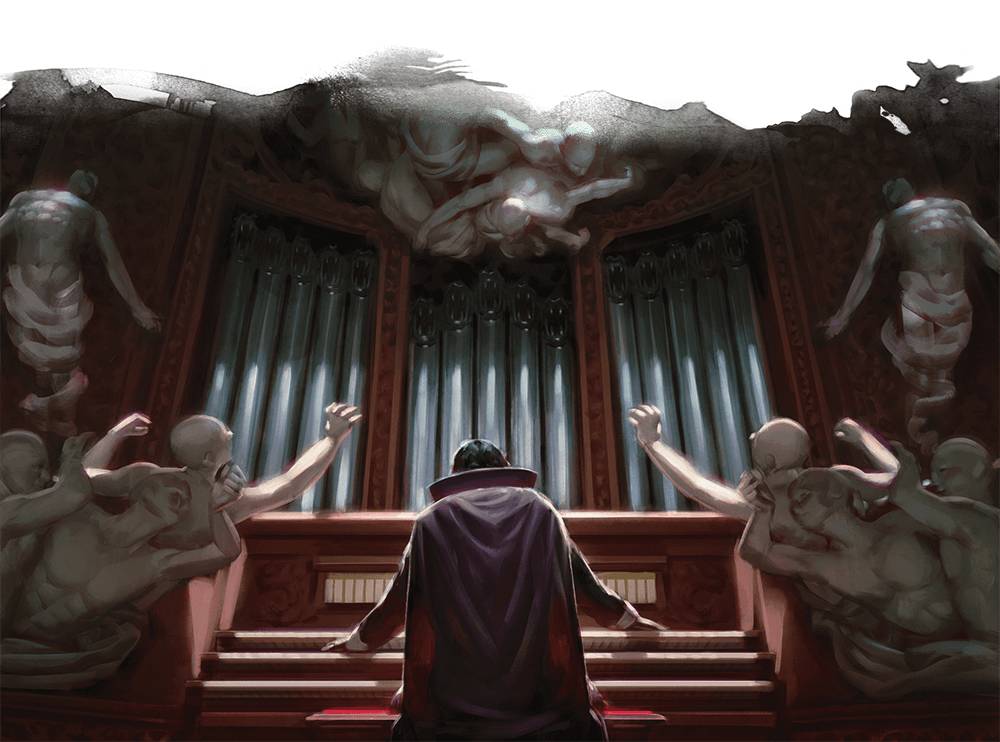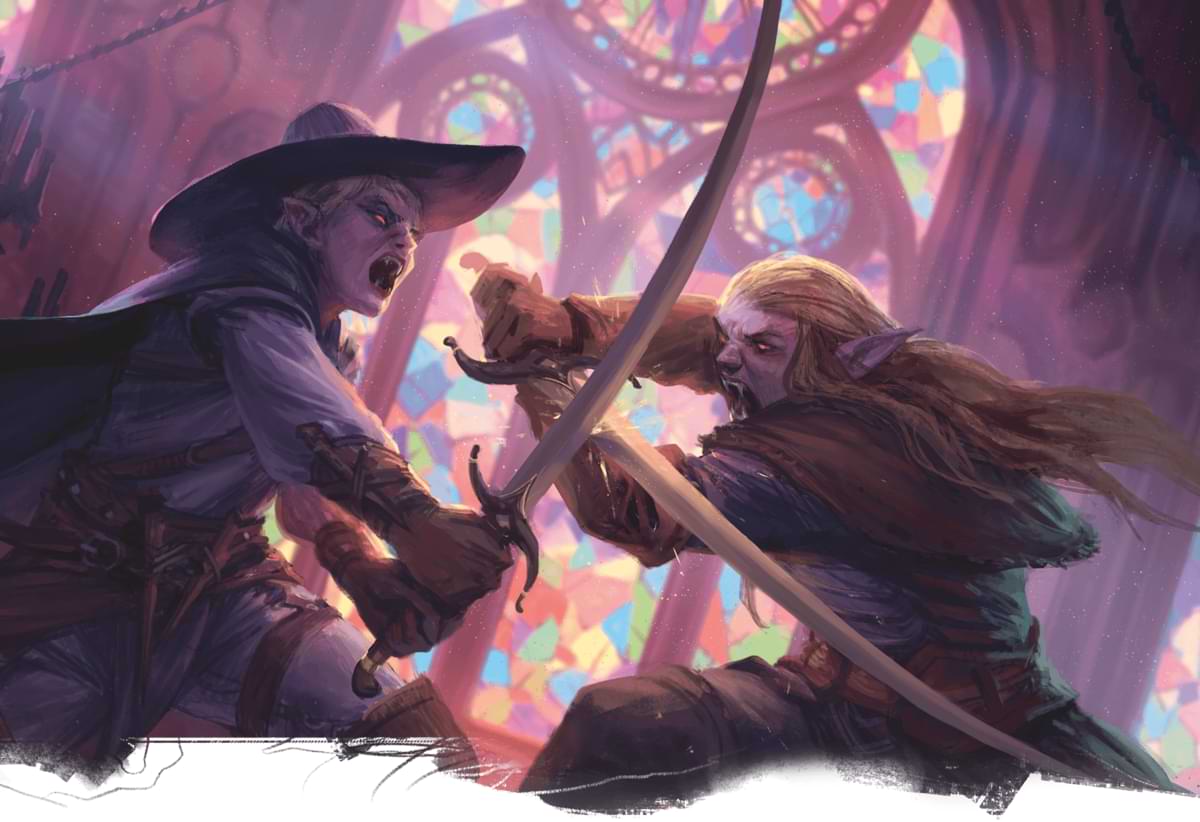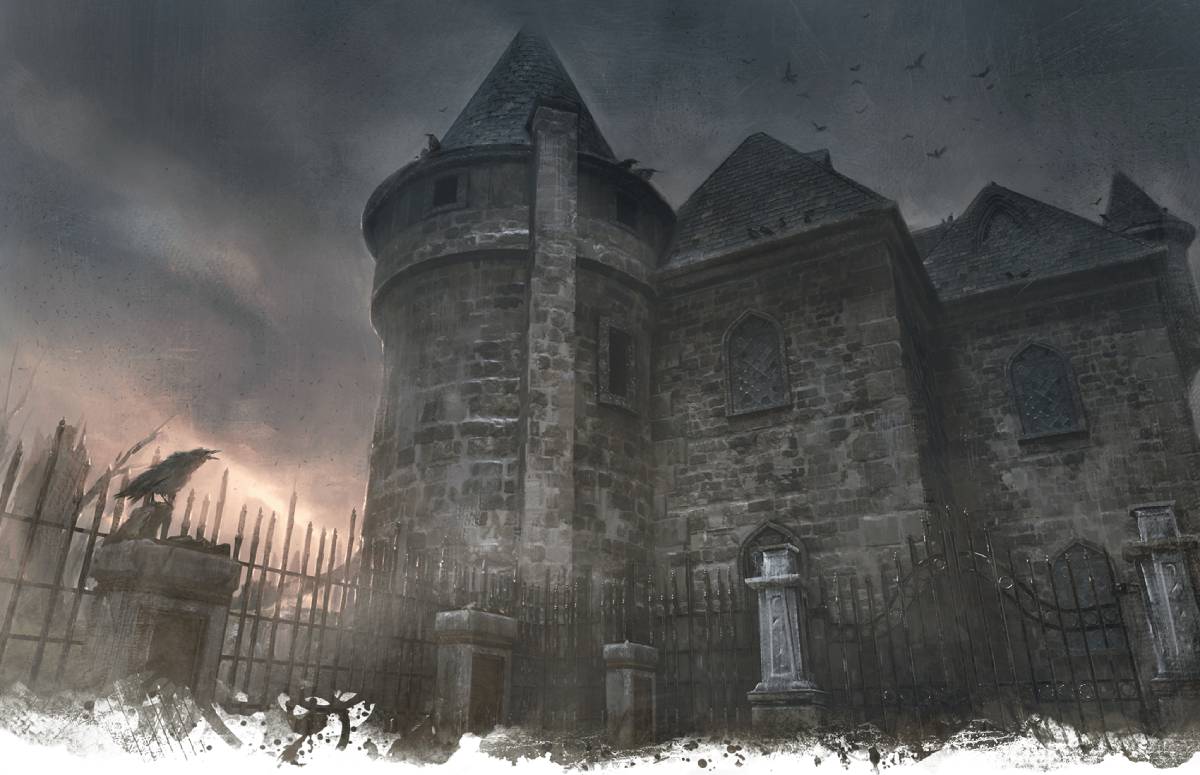Eternal youth, uncanny strength, an irresistible dark charm—who hasn’t fantasized about playing a vampire? Spider climbing up walls in your badass, black, leather outfits, hissing at things, oh yeah, and murdering people so you can drink their blood. Super cool!
There are mechanics for vampire player characters, but the process for becoming a vampire, and the daily realities of playing one, are a lot more involved than you might expect. Let’s break down the lore and the mechanics of vampirism in Dungeons & Dragons and see if the aortic blood is worth the puncture. (See what I did there? Like juice being worth the … squeeze? Nevermind.)
- How to Become a Vampire
- Roleplaying As a Vampire
- The Dhampir: A More Balanced Approach
- Dhampir Character Inspiration From Movies and TV
How to Become a Vampire
 Step 1. Get Bit and Die
Step 1. Get Bit and Die
So. You got bitten by a vampire. This is D&D, it happens. But that doesn’t mean you’re automatically doomed to become a blood sucker. The vampire’s Bite attack can only bestow this dark gift under specific circumstances:
Bite (Bat or Vampire Form Only). Melee Weapon Attack: +9 to hit, reach 5 ft., one willing creature, or a creature that is grappled by the vampire, incapacitated, or restrained. Hit: 7 (1d6+4) piercing damage plus 10 (3d6) necrotic damage. The target’s hit point maximum is reduced by an amount equal to the necrotic damage taken, and the vampire regains hit points equal to that amount. The reduction lasts until the target finishes a long rest. The target dies if this effect reduces its hit point maximum to 0. A humanoid slain in this way and then buried in the ground rises the following night as a vampire spawn under the vampire’s control.
Source: Monster Manual
TL;DR, to become a vampire, you first need to have your hit point maximum reduced to zero by a vampire’s Bite attack. Then, some weirdly specific stuff has to happen.
Step 2. Get Buried
The process for becoming a vampire is rightfully extra. After the vampire’s Bite has reduced your hit point maximum to zero, you must be buried in the ground, where you’ll rise as a vampire spawn the following night.
How buried do you have to be? Six feet deep? What about one foot deep? Does mud count? Do you need a coffin? Why is there so much emphasis on the burial?
“Every vampire remains bound to its coffin, crypt, or grave site, where it must rest by day. If a vampire didn’t receive a formal burial, it must lie beneath a foot of earth at the place of its transition to undeath. A vampire can move its place of burial by transporting its coffin or a significant amount of grave dirt to another location. Some vampires set up multiple resting places this way.”
Source: Monster Manual
TL;DR, the next step to vamping out is getting buried under at least one foot of soil and left to marinate for 24 hours.
Step 3. Await Your Transformation
The next night, your adventuring party looks on in horror as you rise from your grave, seemingly alive, but paler, and drinking from your best friend’s carotid artery.
“The game statistics of a player character transformed into a vampire spawn and then a vampire don’t change, except that the character’s Strength, Dexterity, and Constitution scores become 18 if they aren’t higher. In addition, the character gains the vampire’s damage resistances, darkvision, traits, and actions. Attack and damage rolls for the vampire’s attacks are based on Strength. The save DC for Charm is 8 + the vampire’s proficiency bonus + the vampire’s Charisma modifier. The character’s alignment becomes lawful evil, and the DM might take control of the character until the vampirism is reversed with a wish spell or the character is killed and brought back to life.”
Source: Monster Manual
Yes, you get a +4 modifier to all of your physical attributes and a slew of other abilities and resistances, but please reread the above section before your inner min-maxer starts to salivate, specifically the section about your alignment becoming lawful evil.
TL;DR, it's time to update your character sheet. But don't celebrate just yet. There's more than mechanics that change...
Step 4. Deal With the Fallout
Even if your Dungeon Master hand waves the fact that you become lawful evil, your character’s priorities will change. Their personality may stay the same, or they may become the embodiment of their worst impulses. Either way, you will feel an insatiable thirst for blood and will do anything to quench it. And if you choose to not hunt for blood, your DM has all the fiat they need to seize control of your character and make them do whatever they want, or whatever the true vampire that sired them wants…
“Most of a vampire’s victims become vampire spawn — ravenous creatures with a vampire’s hunger for blood, but under the control of the vampire that created them. If a true vampire allows a spawn to draw blood from its own body, the spawn transforms into a true vampire no longer under its master’s control. Few vampires are willing to relinquish their control in this manner. Vampire spawn become free-willed when their creator dies.”
Source: Monster Manual
And if the possibility of losing control of your character wasn’t enough of a drawback to playing a vampire, here are several additional—albeit very specific—weaknesses you also gain as a vampire:
- You cannot enter a residence without an invitation from someone who lives there.
- Running water can literally melt you.
- If a wooden stake gets driven into your heart while you sleep, you don’t wake up.
- Direct sunlight burns and disorients you.
TL;DR, yeah vampires get yoked out stats, but if you’re not a fan of melting in a creek, creepily asking for permission to enter a residence, or having your character’s agency revoked on a whim, you may get a little frustrated.
Roleplaying As a Vampire
 Before you go flexing all your super cool vampire powers in front of your adventuring party, there are a few things you should know and details to iron out with your DM.
Before you go flexing all your super cool vampire powers in front of your adventuring party, there are a few things you should know and details to iron out with your DM.
Regaining Control of Yourself
All vampires begin their journey under the control of the vampire who sired them. However, if a vampire lets their progeny drink blood from their own body, their spawn will be given free will. Very few vampires choose to give up control of their spawn like this, and for good reason. Most vampires are control freaks, and see their spawn as mere extensions of their will. But other, more ethical vampires may exert this control to reign in their fledgling spawn’s blood lust, choosing to free their spawn once they understand the subtle and dangerous line they must walk between the living and the dead.
Note the wording here is very specific; the true vampire must allow their spawn to draw and drink their blood in order to relinquish their control over them in that manner. The only other way a vampire spawn can achieve free will is if their master dies. So if you’re playing a vampire spawn, and you want out from under the thumb of your master, you need to either find a way to kill them (good luck, considering they have total control over you) or somehow convince them to give up their control over you. This is no easy feat.
If you are playing a vampire that has agency, you and/or your DM should have a clear reason as to why you were granted such a gift by your creator. Maybe you reminded them of a loved one from their mortal life, or perhaps you carried out a deed for them and were granted this as a reward.
Finding a Place to Sleep
Let’s assume you’ve been granted free will by your creator and can now travel with your adventuring party. You can’t travel during the day, but your intrepid band of adventurers can figure out ways around that. Maybe you could sleep inside a carriage, or only move your party under the cover of night, right? Nope. Traveling is going to be quite complicated for you if you’re playing a vampire.
As stated above, you are bound to your coffin, crypt, or grave site. You can’t just crawl into a tent with the rest of your party and take a long rest. You’ll have to find out some way to bring your coffin with you, or (my personal favorite option) carry around a bunch of grave dirt so you can create multiple places to rest.
I have thought of one gnarly workaround for this little snag (fellow DMs, please forgive me for bringing this into the world). If you have a coffin, or a box full of your grave dirt, you could theoretically put it inside of a portable hole and sleep inside it during the day. As a vampire, you don’t require oxygen, so the fact that there’s only 10 minutes of air in a portable hole won’t phase you. So enjoy being a badass vampire with all those super cool powers, because during the day you’ll be forced to sleep in a dirt box.
Contending With Your Past
So, you’ve gained free will as a vampire, you’ve figured out your resting accommodations, and you (and your party) are comfortable with murdering people for sustenance. Everything is gravy now, right? Well…
One thing you should figure out is what, and who, from your previous life you’ve left behind. Your friends and family will age and die while you stay eternally young. At best, you’ll watch all of your loved ones die. At worst, they’ll forsake you for turning into a creature of the night, or even try to kill you. Your loved ones may believe you’re actually dead, and that the foul creature parading around in your body is a mere dark shadow of who you were, a cruel and murderous insult to your memory—and depending on how your DM adjudicates vampirism, they may be right…
The Dhampir: A More Balanced Approach to Blood Sucking

Thanks to Van Richten's Guide to Ravenloft, you can still explore a vampire vibe without the numerous drawbacks, or unbalanced encounters.
Benefits of the Dhampir
The dhampir lineage is “vampire lite” but in the best way possible.
For all intents and purposes, dhampirs are living beings that have, through some uncanny means, been partially transformed by vampiric forces. If you choose to roll a dhampir character, or if you are transformed into one, you maintain any skill proficiencies and special movement speeds gained from your starting species (like climbing, flying, or swimming), and you also gain a modicum of vampiric powers such as increased speed, the ability to walk on walls, and darkvision. You also no longer need to breathe.
However, while you do not inherit a vampire’s laundry list of weaknesses like sunlight or jacuzzis (yeah, a jacuzzi would basically be a vampire fondue pot, think about it), you do gain a vampire’s voracious hunger; a hunger for something that can only be provided by the living through your fearsome bite.
The Bite That Sustains You
Your Vampiric Bite ability grants you one of two boons, which you can draw upon a number of times per day equal to your proficiency bonus.
- You can regain hit points equal to the piercing damage dealt by the bite.
- You can gain a bonus to the next ability check or attack roll you make equal to the piercing damage dealt by the bite.
But unlike garden variety vampires in D&D, dhampirs don’t necessarily have to crave blood. Van Richten’s Guide to Ravenloft provides six possible hungers for you to choose from as a dhampir: blood, flesh or raw meat, cerebral spinal fluid, psychic energy, dreams, and life force energy.
Modifying Your Vampiric Bite
With your DM’s permission, you could modify the dhampir’s Vampiric Bite based on what you feed on:
- If you crave blood, flesh, or cerebral spinal fluid the base mechanics of the bite would remain unchanged. Though if you crave cerebral spinal fluid, just spitballing here, why not give your dhampir a horrid proboscis? Nothing says love like a vampiric, prehensile proboscis ala the strigoi from The Strain.
- If you hunger for psychic energy, maybe your Vampiric Bite is less of a chomp-chompy thing and more of a sinisterly subtle touch attack that deals 1d4 psychic damage in lieu of piercing.
- If dreams are your snack of choice, perhaps your Vampiric Bite only works when you perform a touch attack on a sleeping creature, dealing 1d4 psychic damage to the target while also showing you fragments of the dream you’re consuming.
- If life force is your drink of choice, it could be a touch attack that deals 1d4 necrotic damage.
Dhampir Character Inspiration From Movies and TV

Here are a few popular examples of vampires from movies and TV and how you could make them in D&D. Mild spoilers for these movies and TV shows lie ahead. You’ve been warned!
Blade From Marvel Comics
The titular Marvel character, born with all of a vampire’s strengths and none of their weaknesses. Blade’s origin story lends itself easily to the dhampir lineage. You could’ve been born from a mother that was sired while she was pregnant, passing aspects of vampirism onto you.
If you’re trying to make a Blade-type character, fighter and monk are two great classes to consider.
There are many monk class features that sync harmoniously with the vampire flavor: your preternatural strength could be your Martials Arts die, you can defy gravity with Slow Fall, you can incapacitate your foes with a simple touch via Stunning Strike, and you could even teleport through darkness if you choose the Way of Shadow subclass.
Fighter gives you a plethora of options for a flavorful but optimized vampiric character. If you choose the Unarmed Fighting style, you deal 1d8 damage when fighting fisticuffs. And if you take the Grappler feat, you get advantage on grapple checks and advantage when you attack a creature that’s grappled by you. Bon appetit.
Angel From Buffy The Vampire Slayer
The mysterious and brooding love interest from Buffy the Vampire Slayer. Angel is a vampire cursed to live with a soul, in full awareness of every depraved thing he did as a soulless vampire. Now he fights the forces of evil in hopes that one day he will be redeemed, and made human again.
Perhaps you were a notoriously vicious vampire that left a trail of death and devastation for centuries ... until you made a fateful mistake. You killed the loved one of a powerful cleric, drank from a vessel created for a celestial, or defiled a sacred artifact. As a form of twisted retribution, you have been given back your human soul, but you remember every single horrific thing you did for the centuries you lived as true vampire. Now, as you search for redemption with your adventuring party, you’re constantly reminded of your depraved and bloody past, while still hungering for sustenance from the living. This kind of story fits really well with the rogue’s Phantom subclass. Your Whispers of the Dead feature could be flavored as you being haunted by visions of the innocent people you murdered in your previous (un)life, who reluctantly impart knowledge and wisdom to you.
Alucard From Castlevania
The half-vampire, half-human son of Vlad Dracula Tepesh. Like his father, Alucard is too extra for his own good, so if you’re building an Alucard-type character, they should be Charisma-based and stacked with innate magical abilities. Therefore, I think a warlock Hexblade is a solid choice.
With invocations like Otherworldly Leap, Ascendant Step, Relentless Hex, Thirsting Blade, and Lifedrinker, you can maneuver around the battlefield with uncanny ease, cutting down your foes with an effortless style. And if you’re allowed to equip a dancing sword, that’d be a cherry on top of this bloody sundae.
Your character could be the half-vampire, half-human offspring of a cruel and legendary vampire and the only human they ever loved. If you’re building a vibe off of Alucard, talk with your DM about your character’s complicated relationship with your vampire parent and how that could play out in the long game. What kind of status do you hold as the child of this mythical vampire? Are you an outcast? A noble? A messiah figure?
Maybe your vampiric mother or father ends up becoming a dangerous ally, or maybe you and your friends will be forced into a devastating, emotional, confrontation with them.
Selene From Underworld
The leather-clad, gunslinging Death Dealer that hunts werewolves in a corset. At one point she drinks the blood of the immortal progenitor of the vampire and lycan people, giving her strange powers.
You could roll a dhampir Gloom Stalker ranger, specializing in hunting werewolves and/or wererats. If you add three levels of rogue with the Assassin subclass, you could potentially hunt down and one-shot some lycans! The werewolf versus vampire trope is well-traveled. In the Underworld movies, lycans were once subjucated by vampires, acting as their daylight guardians and enforcers, until they rebelled. Now the two monstrous factions are locked in a hidden war that’s been raging for centuries.
Maybe your Selene-inspired ranger/rogue is an agent of a vampire coven that created dhampirs to replace werewolves as their protectors in the daylight, and hunt down their former guard dogs one by one. This war between vampires and werewolves may be rooted in self interest, but it could also be a pragmatic necessity if you think about it. Vampires tend to give their gift with extreme prejudice, whereas lycanthropy can spread wildly, like a plague, if not kept in check.
Last Words
Beyond vampire player characters being unbalanced and presenting a complicated narrative quagmire for your party, vampires are meant to be (mostly) villains in D&D. Sure, they can be sympathetic and even have incredibly human moments, even acts of kindness, honor, and love, but it doesn’t change the fact that, at their core, they are undead monsters. This is simply how the creature has been written in the game, and trust me, as a DM, a vampire is a tremendously satisfying BBEG to work with.
Vampires are cunning, complicated, vicious, and extremely hard to kill for low-level players. But due to their long list of strange Achilles' heels, it's not impossible for an intrepid group of low-level adventurers to take down a true vampire. Narratively and mechanically, they have more to offer in the hands of a DM than in a player.
But if you want to explore vampire themes with your player character, the dhampir can easily provide a flavorful experience that brings all the right vamp vibes.
Kyle Shire (@kyleshire) is a contributing writer to D&D Beyond and a producer for Critical Role. In the past, he worked as a producer, writer, and host for Machinima Studios and Warner Brothers Interactive Entertainment. He's appeared on HyperRPG as the Mayor of Kollok and the Saving Throw Show. He currently lives in Los Angeles.








-
View User Profile
-
Send Message
Posted Mar 20, 2023Awesome article! I really enjoyed it
-
View User Profile
-
Send Message
Posted Mar 20, 2023I always thought Bladesinger would be a great fit for Alucard's subclass.
-
View User Profile
-
Send Message
Posted Mar 20, 2023Great article.
-
View User Profile
-
Send Message
Posted Mar 20, 2023Okay... as a 31 year DM... this is a good article... and actually makes me like the idea of letting one or more of my PCs... play a vampire LOL
-
View User Profile
-
Send Message
Posted Mar 20, 2023Hey I know this is a blog post but "jacuzzis (yeah, a jacuzzi" is a copyright brand name. You should update to "Hot Tub" or "SwimSpa" .. I know it doesn't roll off the tongue but yeah.. the more you know.
-
View User Profile
-
Send Message
Posted Mar 20, 2023Shalltear is best chair
-
View User Profile
-
Send Message
Posted Mar 20, 2023Wow- this is a fantastic article! Love the depth. Would love to see more of these!
-
View User Profile
-
Send Message
Posted Mar 20, 2023Very useful, thank you!
-
View User Profile
-
Send Message
Posted Mar 21, 2023cool this will help a lot
-
View User Profile
-
Send Message
Posted Mar 21, 2023great article, i'm always a fan of vampire stuff. i just wish in van richten's guide to ravenloft, it gave us sanguimancy or darker themed magic.
-
View User Profile
-
Send Message
Posted Mar 21, 2023Nice article.
The best way to kill a vampire is by beheading them, driving a stake through their heart, and by burning them to ashes. These methods also work well on normal people.
-
View User Profile
-
Send Message
Posted Mar 21, 2023A good short story about vampires is "The Cruel Painter" by George Macdonald. It is a strange story.
Also, if your party member dies by a vampire and you don't want them rising from the dead to drain you of your hard earned blood, I recommend burying them with a sickle over their throat. If they try to get up, off goes their head and the vampire returns to the embrace of death.
-
View User Profile
-
Send Message
Posted Mar 21, 2023... I like it, it's interesting
-
View User Profile
-
Send Message
Posted Mar 21, 2023Ah yes, but you forgot the jacuzzi
also, do regular vampires take damage from running water? if so, what about shape water? that seems too good to be true...
-
View User Profile
-
Send Message
Posted Mar 21, 2023I feel like the magic item Cloak of the Bat has to be mentioned in an article about playing as a vampire. Iconic.
Also, Shadow Magic Sorcerer subclass is a great option too.
-
View User Profile
-
Send Message
Posted Mar 21, 2023Awesome article, thanks.
-
View User Profile
-
Send Message
Posted Mar 21, 2023Awesome article, I’ve always wanted to play as a vampire, when I next play ima try and be a dhampir.
-
View User Profile
-
Send Message
Posted Mar 21, 2023Hot tubs, the true curse of Strahd
-
View User Profile
-
Send Message
Posted Mar 21, 2023Dhampir The Undead Warlock is very fun to play as.
-
View User Profile
-
Send Message
Posted Mar 21, 2023I know some gms who hate conspts of vampirism, tabling them with evil races as they put them but tbh the way I see it is choice and how you reveal this to others can be great for RP